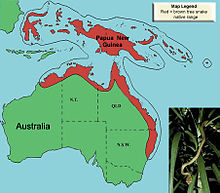Brown tree snake
| Brown tree snake | |
|---|---|
 |
|
| Scientific classification | |
| Kingdom: | Animalia |
| Phylum: | Chordata |
| Class: | Reptilia |
| Order: | Squamata |
| Suborder: | Serpentes |
| Family: | Colubridae |
| Genus: | Boiga |
| Species: | B. irregularis |
| Binomial name | |
|
Boiga irregularis (Merrem, 1802) |
|
 |
|
| Synonyms | |
|
Coluber irregularis Merrem, 1802 |
|
Coluber irregularis Merrem, 1802
Boiga irregularis Fitzinger, 1826
Dipsas irregularis Boie, 1827
Triglyphodon irregularis Duméril & Bibron, 1854
Dipsadomorphus irregularis Boulenger, 1896
The brown tree snake (Boiga irregularis) is an arboreal rear-fanged colubrid snake native to eastern and northern coastal Australia, eastern Indonesia (Sulawesi to Papua), Papua New Guinea, and a large number of islands in northwestern Melanesia. This snake is infamous for being an invasive species responsible for devastating the majority of the native bird population in Guam.
The brown tree snake preys upon birds, lizards, bats, and rats and other small rodents in its native range. It preys on birds and shrews in Guam.
Due to the availability of prey and lack of predators in introduced habitats such as Guam, they have been known to grow to larger sizes than their normal 1 to 2 metres (3.3 to 6.6 feet) in length. The longest recorded length of this species is one found on Guam measuring three metres (9.8 feet).
The reproductive characteristics of the brown tree snake have not been widely studied. The female is known to produce 4-12 oblong eggs, 42–47 millimetres (1.7–1.9 in) long and 18–22 millimetres (0.71–0.87 in) wide with leathery shells. Females may produce up to two clutches per year depending upon seasonal variations in climate and prey abundance. The female deposits the eggs in hollow logs, rock crevices, and other sites where they are likely protected from drying and high temperatures. Populations on Guam may reproduce year round.
...
Wikipedia
